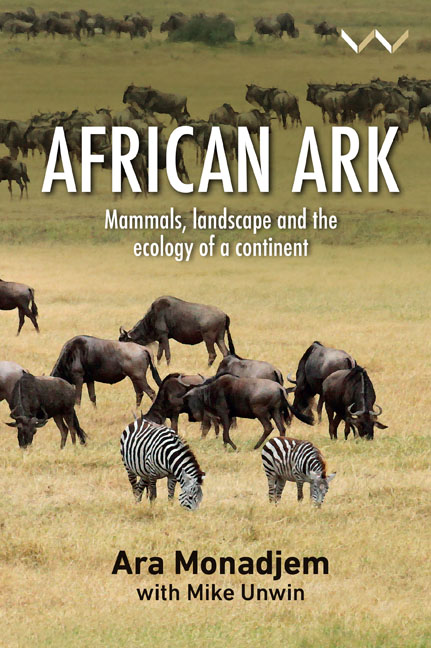Book contents
- Frontmatter
- Dedication
- Contents
- List of Plate Photographs
- List of Figures and Tables
- Acknowledgements
- Foreword
- Preface
- Chapter 1 A Continent of Plenty
- Chapter 2 The Species Conundrum
- Chapter 3 The History of Africa’s Mammals
- Chapter 4 Islands as Species Factories
- Chapter 5 Evolution on the African Mainland
- Chapter 6 Giant Mammals Shaping the Landscape
- Chapter 7 A Place for Every Species
- Chapter 8 Fluctuating Populations
- Chapter 9 The Human Factor
- Chapter 10 The Sinking Ark?
- Glossary
- Notes
- References
- Recommended Reading
- Index
Chapter 3 - The History of Africa’s Mammals
Published online by Cambridge University Press: 29 November 2023
- Frontmatter
- Dedication
- Contents
- List of Plate Photographs
- List of Figures and Tables
- Acknowledgements
- Foreword
- Preface
- Chapter 1 A Continent of Plenty
- Chapter 2 The Species Conundrum
- Chapter 3 The History of Africa’s Mammals
- Chapter 4 Islands as Species Factories
- Chapter 5 Evolution on the African Mainland
- Chapter 6 Giant Mammals Shaping the Landscape
- Chapter 7 A Place for Every Species
- Chapter 8 Fluctuating Populations
- Chapter 9 The Human Factor
- Chapter 10 The Sinking Ark?
- Glossary
- Notes
- References
- Recommended Reading
- Index
Summary
The earliest mammal fossils recorded are from the early Jurassic Period almost 200 million years ago. But in order to flourish, mammals had to wait for the demise of the dinosaurs. This is believed to have come about 66 million years ago, courtesy of a large asteroid strike on what is now the Yucatán Peninsula in Mexico. In the massive worldwide climate disruption that ensued, at least 75 per cent of plant and animal species on Earth became extinct – including all non-avian dinosaurs. This mass extinction ushered in what is traditionally known, somewhat melodramatically, as ‘The Age of Mammals’.
With dinosaurs gone, mammals diversified on land, in the water and in the air, growing within 20 million years from species the size of a large rat to giants standing head and shoulders above the largest elephant alive today. Rodents grew to the size of rhinoceroses, and various groups of elephant- and rhinoceros-like quadrupeds regularly topped the scales at well over ten tons; the largest land mammals included Indricotherium transouralicum, a hornless rhinoceros-like creature from Eurasia, and several species of Deinotherium (relatives of the elephant; see figure 3.1) in Eurasia and Africa (Smith et al. 2010).
We can thus conclude that it was dinosaurs, a group that included the largest animals that ever walked on land, which limited the diversification of mammals. The dinosaurs forced them to the fringes of existence, where they lived mostly as small, furry, scurrying insectivorous creatures, evading the teeth and claws of dinosaurs by seeking shelter in burrows and embracing a nocturnal lifestyle. For this reason, the ancestry of mammals is often depicted as rather unremarkable, overshadowed by the dinosaurs. This chapter aims to convince you otherwise. Mammals have a deep and interesting past, and Africa may well be the best place on Earth in which to study it.
THERAPSIDS: EARLIEST ANCESTORS OF MAMMALS
In Africa, the ancestry of mammals is relatively well documented, thanks to rich fossil deposits in the Karoo rocks of central South Africa, and can be traced back some 300 million years to the earliest synapsids. (Table 3.1 lists the geological eras, periods and epochs relevant to the story of mammals). These early synapsids are collectively called pelycosaurs, and include the well-known Dimetrodon, the creature with an impressive dorsal sail that graces many children's books on dinosaurs, even though it is not one.
- Type
- Chapter
- Information
- African ArkMammals, Landscape and the Ecology of a Continent, pp. 56 - 78Publisher: Wits University PressPrint publication year: 2023



